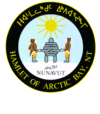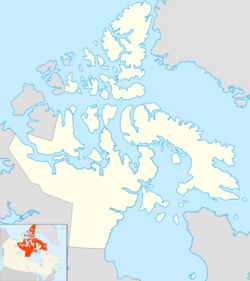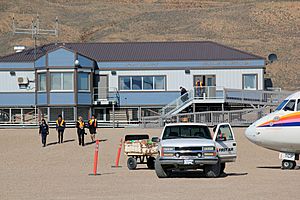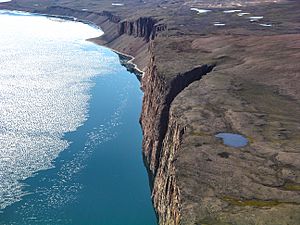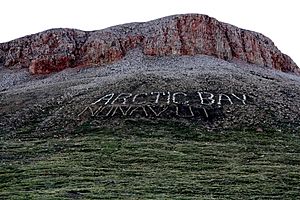Arctic Bay facts for kids
Quick facts for kids
Arctic Bay
|
||
|---|---|---|
|
Hamlet
|
||
| Hamlet of Arctic Bay | ||
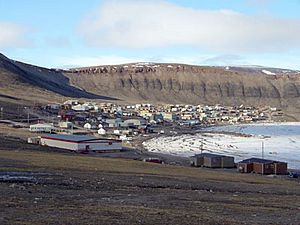
Hamlet of Arctic Bay
|
||
|
||
| Country | Canada | |
| Territory | Nunavut | |
| Region | Qikiqtaaluk | |
| Electoral district | Quttiktuq | |
| Government | ||
| • Type | Hamlet | |
| Area
(2021)
|
||
| • Total | 245.16 km2 (94.66 sq mi) | |
| Elevation | 31 m (102 ft) | |
| Population
(2021)
|
||
| • Total | 994 | |
| • Density | 4.0545/km2 (10.501/sq mi) | |
| Time zone | UTC−05:00 (EST) | |
| • Summer (DST) | UTC−04:00 (EDT) | |
| Postal code |
X0A 0A0
|
|
| Area code(s) | 867 | |
Arctic Bay is a small community in Nunavut, Canada. It is located on Baffin Island, far up north. The local people are called Inuit. In the Inuktitut language, Arctic Bay is called Ikpiarjuk. This means "the pocket".
Even though it's far north, Arctic Bay is in the Eastern Time Zone. People there mainly speak Inuktitut and English. A famous person from Arctic Bay is Eva Aariak. She used to be the leader of Nunavut, called the Premier of Nunavut. Arctic Bay is special because it is the northernmost public community in Canada that was not created by people being forced to move there.
Contents
Exploring Arctic Bay's Past
The area around Arctic Bay has been home to Inuit people for almost 5,000 years. They moved here from the west. In 1872, a European whaling ship named the Arctic sailed through. Its captain, Willie Adams, gave the area its English name.
The Inuktitut name for Arctic Bay is Ikpiarjuk. This name means "the pocket" in English. It describes how the community is surrounded by high hills. These hills make the bay almost completely enclosed. To the southeast, a flat-topped mountain called King George V Mountain stands tall over the community.
Arctic Bay gets its yearly supplies by sealift, which is when ships bring goods. The community also has its own Arctic Bay Airport. There is a road that connects Arctic Bay to Nanisivik. Nanisivik used to be a mining town nearby, but it is now closed.
In April 2007, a church was moved from Nanisivik to Arctic Bay. This helped the community.
On August 10, 2007, the Prime Minister of Canada, Stephen Harper, announced a plan. He wanted to build a naval facility in Nanisivik. This facility would help Canada show its presence in the Arctic.
The original plans for the facility were changed. This was because of problems with the ground that made it more expensive. Now, the facility will be a place for ships to refuel for four months each year. It will mostly be used by the Harry DeWolf-class Arctic patrol ships. Construction started in August 2014. The facility was planned to be fully ready by summer 2020.
Helping Students in Arctic Bay
In October 2020, a clothing company called Canada Goose and Canadian actor Ryan Reynolds made a big donation. They gave over 300 warm coats and boots to students at Inuujaq School. This school teaches students from kindergarten to grade 12.
The donation happened after an activist named Koonoo Han posted on social media. She grew up in Arctic Bay and wanted to help the community.
Arctic Bay's Population
| Federal census population history of Arctic Bay | ||
|---|---|---|
| Year | Pop. | ±% |
| 1976 | 391 | — |
| 1981 | 375 | −4.1% |
| 1986 | 477 | +27.2% |
| 1991 | 543 | +13.8% |
| 1996 | 639 | +17.7% |
| 2001 | 646 | +1.1% |
| 2006 | 690 | +6.8% |
| 2011 | 823 | +19.3% |
| 2016 | 868 | +5.5% |
| 2021 | 994 | +14.5% |
| Source: Statistics Canada |
||
In the 2021 Canadian census, Arctic Bay had a population of 994 people. These people lived in 218 homes. This was an increase from 868 people in 2016. The community covers an area of about 245 square kilometers.
Fun Activities in Arctic Bay
Arctic Bay offers many fun activities and places to go.
Youth Programs
The Royal Canadian Army Cadets meet three times a week. This program is for young people aged 12 and older. They can join and take part in many different activities. Cadets often practice shooting and do outdoor activities. These include hiking, camping, and a sport called biathlon.
Sports and Arts
For adults, there are several sports teams. They meet regularly at the gym attached to the school. Basketball, soccer, volleyball, and hockey are very popular. There is also a hockey rink that is open to everyone in the winter. On Thursday evenings, there is a community art class.
Community Gatherings
The Youth Council helps organize many events for the community. They recently opened a place for community internet use at a local church hall. This hall is also used every week for community Elders to meet and socialize. Other activities and classes also take place here.
The local Community Hall, also known as the Sea Hall, also hosts many fun activities.
Outdoor Adventures
Outdoor activities are very common in Arctic Bay. Some residents still use traditional hunting skills. Most now hunt with guns. Tents are still made by hand and used often in the summer. Ice fishing is a popular activity in the winter. Hunting seals and narwhals is common. This helps provide food and clothing.
Common Canadian events also happen in Arctic Bay. The Terry Fox Run, a charity run, is very popular.
The area is also known for sport hunting of polar bears. This might change as polar bears are now considered a threatened species.
Midnight Sun Marathon
Arctic Bay used to host the Midnight Sun Marathon. This was one of the northernmost running races in the world.
Getting Around Arctic Bay
Flights to and from Arctic Bay arrive at the Arctic Bay Airport. This airport was approved in 2011. This was after a lot of work on the runway and a new terminal building.
Today, you can fly to Arctic Bay with Canadian North. Flights come from Iqaluit and Resolute. Before this airport, small planes would sometimes use the main street as a landing strip. They also used the Nanisivik Airport.
Learning in Arctic Bay
Arctic Bay has one school called Inuujaq School. It teaches students from kindergarten to grade 12. About 200 students attend this school.
There is also a Nunavut Arctic College site. Here, the Nunavut Teacher Education Program (NTEP) is taught. Many local people who finish this program become teachers in the community. Almost all the students are Inuit, and their first language is Inuktitut.
Like most high schools in Nunavut, Inuujaq School uses the Alberta educational curriculum. The school is partly managed by the local District Education Authority (DEA). They help make decisions about rules, spending, and cultural activities.
Staying Connected: Internet in Arctic Bay
The community has been connected to the internet since 2005. This is through the Qiniq network. Qiniq provides wireless internet to homes and businesses. It connects to the rest of the world using satellites.
In 2017, the Qiniq network was updated. It now uses 4G LTE technology for faster internet. It also has 2G-GSM for mobile phone calls.
Arctic Bay's Weather
Arctic Bay has a tundra climate. This means it has long, very cold winters. Summers are short and cool. July is the only month where the average low temperature is above freezing.
The amount of rain and snow is very low, like a desert climate. Most of the precipitation happens between summer and early fall. As the permafrost (ground that is always frozen) melts, some communities like Arctic Bay might face problems. This includes flooding from melting sea ice and erosion from temperature changes.
| Climate data for Nanisivik (Nanisivik Airport) Climate ID: 2402730; coordinates 72°59′N 84°37′W / 72.983°N 84.617°W; elevation: 641.9 m (2,106 ft); 1981–2010 normals |
|||||||||||||
|---|---|---|---|---|---|---|---|---|---|---|---|---|---|
| Month | Jan | Feb | Mar | Apr | May | Jun | Jul | Aug | Sep | Oct | Nov | Dec | Year |
| Record high humidex | −3.0 | 1.2 | −2.2 | −1.2 | 6.5 | 14.5 | 18.4 | 16.7 | 9.0 | 1.2 | −6.3 | −1.3 | 18.4 |
| Record high °C (°F) | −2.0 (28.4) |
2.0 (35.6) |
−3.0 (26.6) |
−0.5 (31.1) |
7.0 (44.6) |
18.5 (65.3) |
18.2 (64.8) |
17.0 (62.6) |
8.5 (47.3) |
2.0 (35.6) |
−6.0 (21.2) |
−4.4 (24.1) |
18.5 (65.3) |
| Mean daily maximum °C (°F) | −26.8 (−16.2) |
−27.2 (−17.0) |
−24.7 (−12.5) |
−16.6 (2.1) |
−7.6 (18.3) |
2.2 (36.0) |
7.5 (45.5) |
3.9 (39.0) |
−3.3 (26.1) |
−11.3 (11.7) |
−19.8 (−3.6) |
−23.6 (−10.5) |
−12.3 (9.9) |
| Daily mean °C (°F) | −29.6 (−21.3) |
−29.9 (−21.8) |
−27.6 (−17.7) |
−19.8 (−3.6) |
−10.3 (13.5) |
−0.1 (31.8) |
5.1 (41.2) |
1.7 (35.1) |
−5.0 (23.0) |
−13.6 (7.5) |
−22.5 (−8.5) |
−26.3 (−15.3) |
−14.8 (5.4) |
| Mean daily minimum °C (°F) | −32.4 (−26.3) |
−32.3 (−26.1) |
−30.1 (−22.2) |
−22.9 (−9.2) |
−13.0 (8.6) |
−2.4 (27.7) |
2.7 (36.9) |
−0.5 (31.1) |
−6.7 (19.9) |
−15.8 (3.6) |
−24.9 (−12.8) |
−28.7 (−19.7) |
−17.2 (1.0) |
| Record low °C (°F) | −48.5 (−55.3) |
−53.0 (−63.4) |
−47.5 (−53.5) |
−42.0 (−43.6) |
−28.3 (−18.9) |
−14.0 (6.8) |
−6.0 (21.2) |
−10.0 (14.0) |
−19.5 (−3.1) |
−35.0 (−31.0) |
−39.4 (−38.9) |
−45.5 (−49.9) |
−53.0 (−63.4) |
| Record low wind chill | −62.9 | −72.3 | −67.0 | −54.8 | −39.4 | −24.9 | −12.8 | −21.0 | −30.3 | −50.0 | −53.5 | −60.6 | −72.3 |
| Average precipitation mm (inches) | 5.4 (0.21) |
5.1 (0.20) |
8.4 (0.33) |
10.9 (0.43) |
24.0 (0.94) |
25.2 (0.99) |
45.7 (1.80) |
45.0 (1.77) |
38.4 (1.51) |
37.4 (1.47) |
18.1 (0.71) |
7.3 (0.29) |
270.9 (10.67) |
| Average rainfall mm (inches) | 0.0 (0.0) |
0.0 (0.0) |
0.0 (0.0) |
0.0 (0.0) |
0.1 (0.00) |
6.7 (0.26) |
37.0 (1.46) |
29.2 (1.15) |
4.4 (0.17) |
0.0 (0.0) |
0.0 (0.0) |
0.0 (0.0) |
77.3 (3.04) |
| Average snowfall cm (inches) | 5.4 (2.1) |
5.2 (2.0) |
8.4 (3.3) |
11.2 (4.4) |
24.0 (9.4) |
17.7 (7.0) |
8.5 (3.3) |
15.0 (5.9) |
32.3 (12.7) |
38.2 (15.0) |
17.9 (7.0) |
7.5 (3.0) |
191.3 (75.3) |
| Average precipitation days (≥ 0.2 mm) | 4.4 | 4.6 | 6.2 | 5.7 | 9.6 | 8.8 | 12.4 | 12.6 | 13.3 | 14.2 | 8.4 | 6.3 | 106.5 |
| Average rainy days (≥ 0.2 mm) | 0.0 | 0.0 | 0.0 | 0.0 | 0.0 | 2.2 | 10.4 | 8.1 | 1.7 | 0.0 | 0.0 | 0.0 | 22.3 |
| Average snowy days (≥ 0.2 cm) | 4.4 | 4.6 | 6.2 | 5.8 | 9.6 | 7.1 | 3.0 | 5.4 | 12.1 | 14.3 | 8.5 | 6.4 | 87.3 |
| Average relative humidity (%) | 64.1 | 65.0 | 66.6 | 71.2 | 81.3 | 80.7 | 75.6 | 84.9 | 88.6 | 89.7 | 72.9 | 68.7 | 75.8 |
| Source: Environment and Climate Change Canada Canadian Climate Normals 1981–2010 | |||||||||||||


